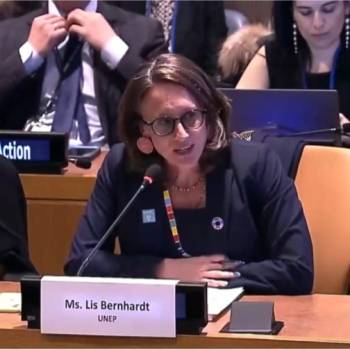
September is the start of the year for the fashion world, a big month where designers showcase their new looks on runways in New York, Paris, Milan, and London. Yet away from the glitz and glamour of these trend-setting shows there are concerns that the fashion industry is taking a heavy toll on the planet.
The clothing sector produces between 2 and 8 per cent of global carbon emissions, while textile dyeing is a major polluter of water. Fast fashion – where clothes move from idea to design to the mass market as quickly as possible – plays a huge role in this. The average person is buying 60 per cent more clothing than 15 years ago, while each item is kept for only half as long.
We recently spoke with Garrette Clark, a sustainability expert with the United Nations Environment Programme (UNEP), about how you can be on-trend while having a lighter impact on the planet. Here are some ideas.
Think about your purchases
Every second, the equivalent of one garbage truck of textiles is dumped in a landfill or burned. Many of those clothes are impulse buys and some hardly worn. “Unnecessary consumption is driving the problem,” says Clark. “Rather than impulsively buying a pair of boots, ask yourself: what do you really need, and do you want to follow trends or set them? From there, think of the least impactful way to design your look.”
Consider second-hand clothes
It takes thousands of gallons of water to make a single pair of jeans, one of the many reasons Clark says you should look into second-hand apparel. It takes time and effort but try to tune out the fashion marketing machine that is constantly pushing new designs. Clark urges people to celebrate “their uniqueness by designing a wardrobe based on pieces that are vintage, handmade, and swapped.” Have fun seeking out new treasures, she says.
Buy better quality apparel
While cheap clothes may seem like a better value, and for many are the only option, they also contribute to our environmentally harmful disposable economy, Clark says. Lower quality apparel is often quickly thrown out and may not be worn at all. If you can afford it, she recommends buying good quality, long-lasting clothes and taking care of them. That will be better for the environment and the people who made them, and, in the long run, be easier on your wallet.
Give your clothes a second life
When your clothes are getting worn, Clark suggests repairing or upcycling them. If you are finished with a piece of clothing, swap it, give it to a friend, or donate it. With the fashion industry poised to use up a quarter of the world’s carbon budget by 2050, giving clothes a second life can help counter climate change.
Rather than impulsively buying a pair of boots, ask yourself: what do you really need, and do you want to follow trends or set them?
Garrette Clark, UNEP
Stay curious
It’s important to research the clothes you’re buying, Clark says. Ask questions like:
- Do clothes makers disclose their sustainability activities? Can those claims be verified?
- Do they source sustainable fabrics or use recycled fibres?
- Are they making efforts to ensure their supply chains address their impacts on the planet?
- Do they use certified labels so they can be compared?
To find answers look to the internet and read clothing labels. But be cautious about what you read; greenwashing is frequent, so common sense is key. There are third-party websites you can visit to check the environmental credentials of brands, such as Good On You.
Let brands and the world know what you want
People have power and can demand fashion brands to act more sustainably – and governments to make sustainable options the default option. “There is a growing awareness among consumers about the issues we are facing. [We] now all have access to social media and [can] share our opinions online,” Clark says. Consumers can ask brands to reduce excess fashion and communicate their product impacts.
What is the most effective way to pressure brands? Clark says the options are as varied as the fashion choices on offer. “For some people, voting with their wallet is the way to go, and for others, intense social media advocacy will fit the bill,” she says.
Posted on 2022-10-04 11:55








Comments